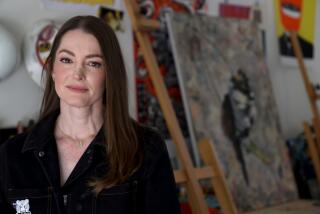Staying lean to focus on creative sparks
- Share via
Elaine Cantwell’s business strategy can be summed up in three words: small by design.
Designer Cantwell has set up Spark Creative Inc. to allow her to devote her time to crafting award-winning broadcast graphics and promotions for clients such as Showtime Networks Inc., Canada’s W Network and Target Corp.
She relies on the company’s three employees and a few trusted outside vendors to handle the back-office duties and production support that would take her away from the creative work she loves.
“The focus of this company is on creative quality,” said Cantwell, who left her post as vice president and creative director at Hollywood-based 3 Ring Circus, a much larger design company, to launch Santa Monica-based Spark in 2002.
Too often small-business owners find themselves swamped in the minutiae of running a company, struggling to find time for the skilled work that spurred them to start their companies in the first place.
Some don’t mind their gradual transformation into managers. Others, like Cantwell, fight the pressure. For them, small is beautiful and a smart business strategy.
Cantwell knows that Spark clients come to the high-profile firm for her innovative designs, including Showtime’s relaunch package that won the Broadcast Design Assn.’s Best of Show award in 1999 and work for ABC Sports that brought an Emmy Award in 1998. To fill that demand, Cantwell devotes about 90% of her time to the creative side of the business.
That focus has helped keep the company small. Annual revenue has averaged $1.5 million to $3.5 million in the almost five years since the Irish-born owner started the business.
For Cantwell, who worked at a large Dublin, Ireland, advertising agency on a Guinness & Co. account before coming to Los Angeles in 1993, the company’s size is a competitive advantage.
“It’s a very fast-changing environment, and in order to compete you have to be very limber and very much aware of what’s going on,” Cantwell said. “Right now, the smaller companies are the ones that seem to be able to survive and also provide the services the clients need.”
By staying small, Spark and other small businesses also can more easily avoid overextending their resources. That can make it easier to weather seasonal slow times, economic downturns and the sometimes lengthy wait for a client to give a proposed project the go-ahead.
“She is a very strong small company and we keep it lean and mean,” said David Kovacs, the Sherman Oaks-based certified public accountant who handles back-office tasks for Spark and several dozen other small firms in the entertainment industry. He is also a former chief financial officer and chief operating officer at 3 Ring Circus.
In the early 1990s, big was the operative word for the broadcast design industry, which in Los Angeles consisted largely of three big companies, including Pittard Sullivan, Cantwell’s first employer when she came to the U.S.
Since then, many of the industry heavyweights have closed their doors or shriveled in size as the business has fragmented into hundreds of small firms and thousands of freelancers. Pittard Sullivan, for instance, is gone and 3 Ring Circus is down to about 15 employees from 50.
The change came partly because technology has gotten cheaper. A designer today can use a $10,000 Macintosh computer to do the work that required a $1-million machine in the early 1990s. Clients expect to pay less because they know it costs less to do the same work.
“It’s very difficult to keep a large company in this industry because of the ability of the client to control the budget,” Kovacs said. “It used to be the creative company could control the budget because there were not a lot of alternatives.”
The larger number of competitors is supported by the increased amount of work, he said. Instead of just a few networks and cable channels that stuck with programs to build viewership, today’s multiple media distribution channels might create shows to last for two months or less. Each of those shows and their distribution channels need new or updated graphic designs to capture the attention of busy viewers.
Running a small operation can have potential downsides. Companies such as Spark rely on flocks of freelancers for specialty services. In some cases, access to top-notch freelance talent in areas such as 3-D animation can be a challenge because of the high demand for such work.
Small companies also have to find time to bring in new business and to generate revenue. It can be tough to find qualified outside help to do those jobs and see eye to eye with an owner, Kovacs said.
Keeping tabs on the business also is crucial, especially for an owner who is focused on the creative end.
“Staying in touch with the overall pulse of the business is important,” said Mike Stull, director of the Inland Empire Center for Entrepreneurship and associate business professor at Cal State San Bernardino.
“That’s the catch,” he said. “How do you find your best balance?”
Cantwell relies on a flexible staff, including production head Patty Kiley, whom she has worked with at other companies.
Kiley meets Kovacs roughly every other week to exchange paperwork and is in contact with him several times a week.
And Cantwell meets with the accountant quarterly for a big-picture view of the company as well as for an annual review of the year and tax planning.
Cantwell reviews a bimonthly financial report supplied by Kovacs and signs all the checks that leave the company.
“Fortunately I have found those people I trust implicitly and they have as much vested in the success of Spark as I do,” Cantwell said. “So it works.”
*
(BEGIN TEXT OF INFOBOX)
Back story
Name: Spark Creative Inc.
Business: Broadcast and commercial design
Owner: Elaine Cantwell
Founded: January 2002
Employees: Three
Location: Santa Monica
Strategy for success: Owner spends 90% of her time on design work and outsources some of the office duties.
Source: Times research
Los Angeles Times
More to Read
The biggest entertainment stories
Get our big stories about Hollywood, film, television, music, arts, culture and more right in your inbox as soon as they publish.
You may occasionally receive promotional content from the Los Angeles Times.










